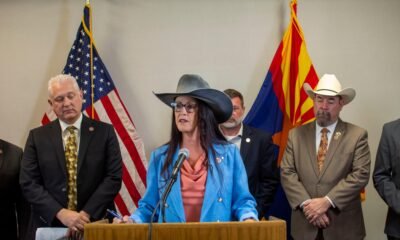family
Flu Deaths Surge Amid Growing Anti-Vaccine Misinformation

Americans are grappling with the highest influenza death toll since 2018, as vaccine skepticism grows within state legislatures and political circles. Preliminary federal statistics reveal that approximately 9,800 flu-related deaths occurred in January and February, marking a significant increase from 5,000 deaths during the same period last year. This surge is unprecedented since 2018, when about 10,800 deaths were reported.
In light of these alarming figures, the U.S. Department of Health and Human Services has postponed critical meetings focused on next fall’s flu vaccine preparation. Such delays have sparked outcry from medical professionals and lawmakers alike. U.S. Senator Kirsten Gillibrand, a Democrat from New York, highlighted that her state is enduring its worst flu season in over 15 years, compounding pressures on the health care system.
Health experts contend that postponing vaccine planning feeds misinformation and undermines public confidence in vaccination efforts. Dr. Akram Khan, an associate professor at Oregon Health & Science University, criticized the delays as detrimental to pandemic preparedness. In contrast, U.S. Health and Human Services Secretary Robert Kennedy Jr. has expressed skepticism about the necessity of flu vaccines, despite their proven efficacy in reducing mortality and hospitalization rates.
Flu death rates tend to vary yearly based on the severity of circulating strains and vaccine effectiveness. However, hesitancy surrounding vaccinations, fueled by misinformation and political distrust, is already claiming lives. Mark Doherty, a vaccine scholar, noted a noticeable increase in viral respiratory infections across the Northern Hemisphere, with the U.S. experiencing a particularly difficult season.
Statistics indicate that flu vaccine distribution in the U.S. has dropped significantly, with a decline of 16% recorded as of early 2025. The Centers for Disease Control and Prevention reported that flu was a factor in the 9,800 deaths during the season’s peak months. States such as Oklahoma, Minnesota, and Pennsylvania have experienced the highest mortality rates, with severe impacts visible in older demographics and minority populations.
Tragic stories have emerged nationwide, underscoring the flu’s impact. A 43-year-old father from Indiana recently died from a brief flu illness, while schools in Maryland initiated vaccine clinics following the deaths of two children. Community leaders, like Pastor Doug Sides in Florida, have witnessed multiple deaths within his congregation, highlighting the gravity of the flu’s toll.
Pastor Sides promotes hygiene practices among his church members but faces conflicting advice about flu vaccinations, illuminating the confusion surrounding vaccine recommendations. Meanwhile, states are increasingly relaxing vaccine requirements, which poses further challenges to public health messaging. Despite the rising skepticism, local health departments, like that of Burlington County, New Jersey, are putting forth efforts to promote vaccine safety through free clinics.
In Oklahoma, public health efforts emphasize the safety and accessibility of flu shots, yet vaccination rates remain low; only about 16% of residents had received the flu vaccine by December. States showing higher vaccination rates, such as Maine and Vermont, still reflect declines from previous years, indicating a broader trend of increasing hesitancy.
This vaccine hesitancy, particularly in rural areas, often arises from distrust in vaccines and the medical establishment. Health professionals highlight that deeply rooted attitudes toward vaccines are not easily swayed by scientific data alone. A contemporary report illustrated that personal anecdotes and societal influences often dictate public health behavior, complicating the mission to combat misinformation surrounding vaccines.
“Unfortunately, vaccine hesitancy is deeply entangled with misinformation, political rhetoric, and public distrust,” Khan noted. However, positive engagement from trusted healthcare providers may effectively shift public perceptions and encourage greater acceptance of influenza vaccinations.


















